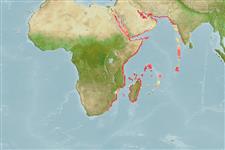>
Blenniiformes (Blennies) >
Tripterygiidae (Triplefin blennies) > Tripterygiinae
Etymology: Enneapterygius: Greek, ennea = nine times + Greek, pterygion = little fin (Ref. 45335).
Environment: milieu / climate zone / depth range / distribution range
นิเวศวิทยา
เกี่ยวกับทะเล,น้ำเค็ม สัตว์น้ำหน้าดิน; ระดับความลึก 0 - 12 m (Ref. 12476), usually 0 - 1 m (Ref. 12476). Subtropical
Western Indian Ocean: east and soitheast coast of South Africa (Transkei to southern Mozambique), the Red Sea, Aden, Oman, and Pakistan.
ขนาด / น้ำหนัก / Age
Maturity: Lm ? range ? - ? cm
Max length : 4.0 cm TL เพศผู้/กระเทย; (Ref. 11441)
เงี่ยงครีบหลัง (รวม): 14 - 16; ก้านครีบอ่อนที่หาง (รวม): 8-10; เงี่ยงครีบก้น 1; ก้านครีบอ่อนที่ก้น: 17 - 20. This species is distinguished by the following characters: D III + XI-XIII + 8-10 (usually III + XII + 10); A I,17-20 (usually 19); pectoral fin 14: 1-3, 4-6, 6-8 (usually 2, 5, 7). LL, pored scales 13-16, notched scales 21-25, starting at 2 scale rows below the end of the pored series; transverse scales 2/6; nape and abdomen scaleless, first dorsal fin base also without scales. Body depth 4.8-5.2 in SL. Head 3.4-4.0 in SL; eyes large, diameter 3.0-3.7 in head length; orbital cirrus moderate, lobate; supratemporal sensory canal U-shaped and embraces 1st dorsal spine; dentary pores 3+1+3. Male first dorsal fin slightly higher than second; slightly lower in females. Key features are: overall olive green; anal fins black and white barred. Males head black; first dorsal fin, lower pectoral-fin rays and proximal portion of the pelvic-fin rays yellow females (Ref. 57774, 88983).
Female members of the Tripterygiidae have eggs that are hemispherical and covered with numerous sticky threads that anchor them in the algae on the nesting sites (Ref. 240). Larvae are planktonic which occur primarily in shallow, nearshore waters (Ref. 94114).
Holleman, W. and S.V. Bogorodsky, 2012. A review of the blennioid fish family Tripterygiidae (Perciformes) in the Red Sea, with description of Enneapterygius qirmiz, and reinstatement of Enneapterygius altipinnis Clark, 1980. Zootaxa 3152:36-60. (Ref. 88983)
IUCN Red List Status (Ref. 130435)
Threat to humans
Harmless
Human uses
ข้อมูลเพิ่มเติม
ชื่อสามัญชื่อพ้องกลไกการเผาผลาญพลังงานผู้ล่าการศึกษาเกี่ยวกับผลกระทบของสารประกอบทางเคมีที่เป็นอันตรายต่อสิ่งมีชีวิต ประชากร และสิ่งแวดล้อมการสืบพันธุ์วัยเจริญพันธุ์การวางไข่การรวมกลุ่มวางไข่ความดกของไข่เซลสืบพันธ์ของเพศเมีย(ไข่)Egg development
อ้างอิงการเพาะเลี้ยงสัตว์น้ำประวัติการเพาะเลี้ยงสัตว์น้ำสายพันธุ์พันธุศาสตร์ElectrophoresesอัตราพันธุกรรมโรคการแปรรูปNutrientsMass conversion
ผู้ร่วมมือรูปภาพหลายรูปStamps, Coins Misc.เสียงปลามีพิษ เช่น ปลาปักเป้าความเร็วรูปแบบการว่ายน้ำพื้นที่เหงือกOtolithsสมองวิสัยทัศน์
เครื่องมือ
Special reports
Download XML
แหล่งที่มาจากอินเตอร์เน็ต
Estimates based on models
Preferred temperature (Ref.
123201): 24.8 - 28.9, mean 27.2 °C (based on 725 cells).
Phylogenetic diversity index (Ref.
82804): PD
50 = 0.5000 [Uniqueness, from 0.5 = low to 2.0 = high].
Bayesian length-weight: a=0.00562 (0.00258 - 0.01228), b=3.08 (2.89 - 3.27), in cm total length, based on LWR estimates for this (Sub)family-body shape (Ref.
93245).
ระดับชั้นอาหาร (Ref.
69278): 3.1 ±0.3 se; based on size and trophs of closest relatives
ความสามารถในการกลับคืนสู่ปกติ (Ref.
120179): ความสูง, เวลาต่ำสุดที่จะทำให้ประชากรเพิ่มขึ้นเป็น 2 เท่าใช้เวลาน้อยกว่า 15 เดือน (Preliminary K or Fecundity.).
Fishing Vulnerability (Ref.
59153): Low vulnerability (10 of 100).
